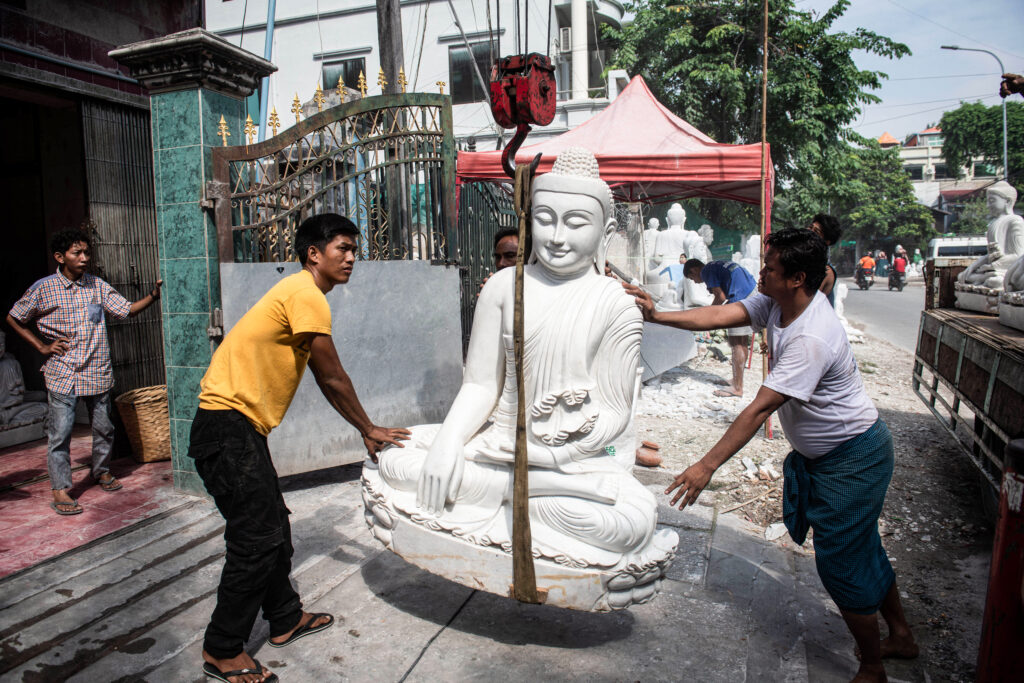Sculptor Aung Naing Lin has spent decades carving Buddha statues to help guide Myanmar’s faithful — but getting the marble he needs from rebel-held quarries in the midst of civil war is now a perilous task.Buddhist-majority Myanmar has been mired in bloody conflict since the military toppled the government of Aung San Suu Kyi in 2021, terminating a 10-year experiment with democracy and sparking a widespread armed uprising.In recent months, opponents of the military have advanced with rocket and drone attacks on Mandalay — the country’s second-biggest city, with a population of 1.5 million.The rebels have also seized the hillside quarries that have for generations provided the marble that adorns Mandalay’s palaces and monasteries, as well as the shrines in ordinary homes.Now, moving the precious stone and roughly carved statues by truck across the divide of the civil war, from rebel to junta-held territory, is expensive, difficult and dangerous.”The situation around the Madaya township (where the quarries are located) is not very good,” Aung Naing Lin told AFP at his noisy workshop in Mandalay, his face and hair speckled with white dust.”It is not easy to go, and we cannot bring the stones back.”Surrounded by dozens of blank-faced Buddha statues waiting to be given eyes, ears and lips, Min Min Soe agreed.”Sales are not that bad, but the challenge is bringing the statues here,” he said.”We can sell only the statues we have here and we cannot bring new raw statues in.”The owner of another workshop, who did not want to be named, said associates of his were recently arrested when taking a shipment of marble from rebel-held Madaya.”They were detained by the local military column and were asked how they brought the stones out from the village as that area was controlled by the PDF,” they said.”People’s Defence Forces” are units made up of former students, farmers and workers who have left their lives behind to take up arms and oppose the junta’s coup.There are dozens of PDFs across the country, and they have dragged the junta into a bloody stalemate.The junta has designated them as “terrorists”, and contact with them can bring years in prison.”Later, they released the people who had been detained and gave the stones back,” the workshop owner said.”It’s like a warning to all. We dare not to bring stones from the village under this situation.”- Madaya quarries -The quarries of Madaya have long been interwoven with the cultural and religious history of Myanmar.In the 1860s, following two disastrous wars with the British, then-king Mindon commissioned craftsmen in Mandalay to transfer Buddhist scriptures from palm leaf manuscripts onto 720 blocks of solid marble to ensure they survived any further destruction.The stone also resonates with the military that has ruled Myanmar for much of its history since independence from Britain in 1948.In 2020, it sanctioned the building of a 25-metre (82-foot) high statue of the Buddha made from Madaya marble to adorn its custom-built capital Naypyidaw.Junta chief Min Aung Hlaing declared the statue finished last year and a visit has since become a stock feature of the itineraries of the few foreign delegations that visit the isolated junta.- ‘Living Buddhas’ -While the fighting continues north of Mandalay, Min Min Soe and others work to put the finishing touches on the dozens of roughly hewn statues. Their forefathers used chisels, but nowadays, craftsmen use drills to etch everything from Buddha’s face, the folds in his robe, fingernails and the lotus flower he sits on.The laborious final stages of smoothing the rough edges are done by women using sandpaper, said Min Min Soe.”Women are better at this as they are more patient,” he said.A finished statue around 25 centimetres (10 inches) high fetches between 100,000 – 200,000 Myanmar kyat ($50-$100 at the official exchange rate), he said.Outside one of the workshops on the busy street, workers packed a sitting Buddha statue into a wooden protective frame before shipping it off to a customer.Min Min Soe says looking after the dozens of his creations still in stock helps him find his own peace amid rumours of an attack on Mandalay.He considers them “living Buddhas”.”I clean the statues at 4 am every day… This is not only for my business but also to gain merit,” he said.”I want them to be clean and good-looking no matter if they are sold or not.”
Tue, 05 Nov 2024 03:01:16 GMT
